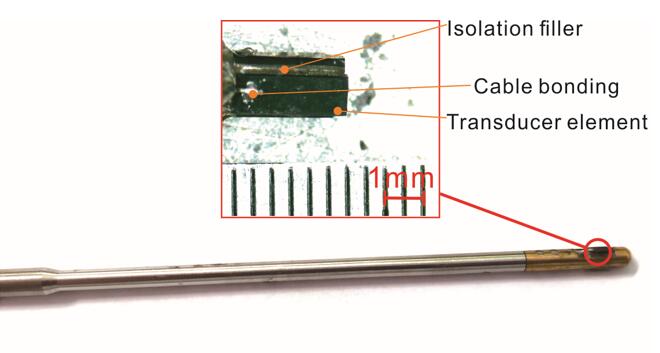Endoscopic ultrasound (EUS) plays a vital role in the development of novel treatment and diagnostic methods of gastrointestinal diseases. For the EUS imaging system, the ultrasonic transducer is an essential component, whose working frequency determines the quality of ultrasonic images. In general, the higher the working frequency, the easier it is to obtain high-quality images. Nevertheless, increasing the frequency often leads to a decrease in detection depth, which limits the imaging range and is unfavorable in clinical use.
Conventional EUS transducers generally work at a single frequency, ranging from 5 to 20 MHz. If an operator wants to alter the working frequency to obtain suitable depth, another probe must be employed, thereby causing inconvenience in clinical use and making patients suffer more. However, multi-frequency imaging and the matched image fusion technique have the potential to solve the issue that limits the performance of the EUS imaging system.
Recently, the medical ultrasound research team from Suzhou Institute of Biomedical Engineering and Technology of Chinese Academy of Sciences has developed a multi-frequency and large-bandwidth ultrasonic probe based on piezoelectric composite materials, which balances imaging resolution and imaging depth. In this research, a triangle-structure triple-frequency transducer that can work at three different frequencies is presented, whose outer diameter is less than 1.5mm. Static and transient models are built to assist its design. Specifically, simulation results and sound field measurement results suggest that the three different frequency elements have excellent directivity, and the acoustic field interference among the elements is small; pulse-echo results show that center frequencies of the elements are 13.17MHz, 20.3MHz, and 30.85MHz respectively; ultrasound imaging results of phantom indicate that the triple-frequency fusion imaging is better than the single-frequency imaging, and the fused image can achieve an excellent balance between image resolution and imaging depth. In short, this research proves the feasibility of a triple-frequency transducer in endoscopic imaging and shows its great potential in the diagnosis of gastrointestinal diseases.
The research article "A triple-frequency transducer for endoscopic imaging: Simulation design and experimental verification" has been published in Sensors and Actuators A: Physical
This research is supported by National Natural Science Foundation of China, Foundation of the Jiangsu Social Development - Clinical Frontier Technology, and Youth Innovation Promotion Association of Chinese Academy of Sciences.

Figure 1. The triple-frequency transducer. (Image by SIBET)

Figure 2. The fused ultrasound image of multi-layer mimicking phantom. (Image by SIBET)
Contact
XIAO Xintong
Suzhou Institute of Biomedical Engineering and Technology, Chinese Academy of Sciences (http://www.sibet.cas.cn/)
Phone: 86-512-69588013
E-mail: xiaoxt@sibet.ac.cn